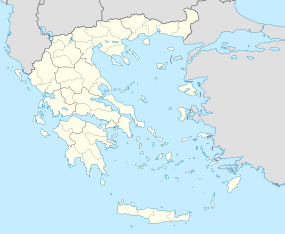Vari Cave

A relief depicts the builder of the sanctuary, Archedemus the nympholept, near the steps in the cave.
|
|
| Alternate name | Nympholyptos Cave |
|---|---|
| Location | Vari, Attica, Greece |
| Coordinates | 37°51′30″N 23°48′06″E / 37.85833°N 23.80167°ECoordinates: 37°51′30″N 23°48′06″E / 37.85833°N 23.80167°E |
| Type | Sanctuary |
| History | |
| Builder | Archedemus of Thera |
| Founded | 6th century BC |
| Abandoned | Approximately 6th century AD |
| Periods | Archaic Greece to Hellenistic period, later Roman Empire |
| Site notes | |
| Excavation dates | 1901 |
| Ownership | Public |
| Management | Ephorate of Palaeoanthropology and Speleology of Southern Greece |
| Public access | No |
| Website | Nympholyptos cave at Vari |
The Vari Cave, also known as the Nympholyptos Cave (Greek: Σπήλαιο Νυμφολήπτου Βάρης), is a small cave northeast of Vari in Attica, Greece. In classical antiquity the cave was used as a shrine dedicated to Apollo, Pan and the Nymphs. The cave was occupied from the sixth to second century BC. The cave then fell into disuse until it was occupied again in the fourth century AD. It was finally abandoned in approximately the sixth century. The cave was excavated in 1901.
It lies near the top of one of the southern spurs of Mount Hymettus at an altitude of almost 300 meters. From Vari, it can be reached on foot in one hour. The cave is unique in Greece because of its rock-cut sculptures. The marble votive tablets from the cave are now exhibited at the National Archaeological Museum of Athens.
Because of its use for the veneration of Pan the cave is also called the Cave of Pan. It was one of the five caves of Pan in the vicinity of ancient Athens.
According to inscriptions found in the cave, the sanctuary was built by Archedemus of Thera. He identified himself as a nympholept and states that he built the sanctuary "at the Nymph's counsel". Archedemus has a cross on his right shoulder that has as yet found no explanation.
Unlike many other caves, prehistoric remains were not found. The earliest inscription found in the cave was dated to approximately the beginning of the sixth century BC. A relief depicting Archedemus is dated to approximately 400 BC, most likely during the apex of the sanctuary's popularity. A second-century coin from Athens found in the cave provides evidence that it was continuously occupied from about 600 BC to 150 BC.
...
Wikipedia

